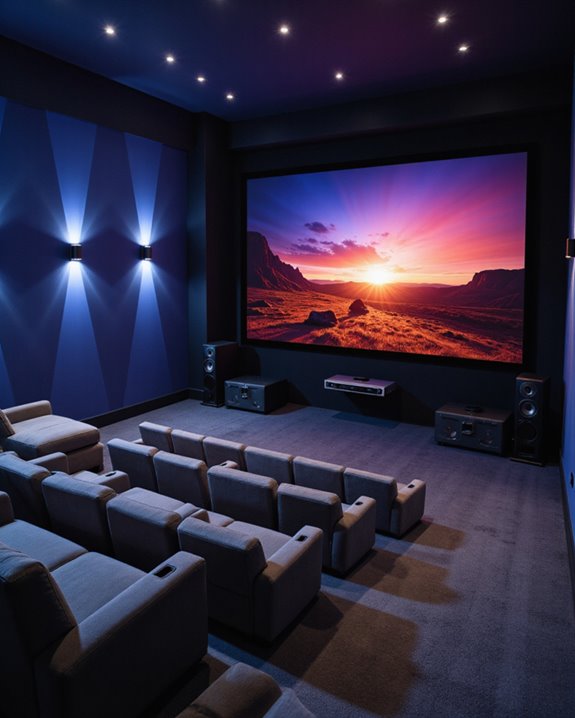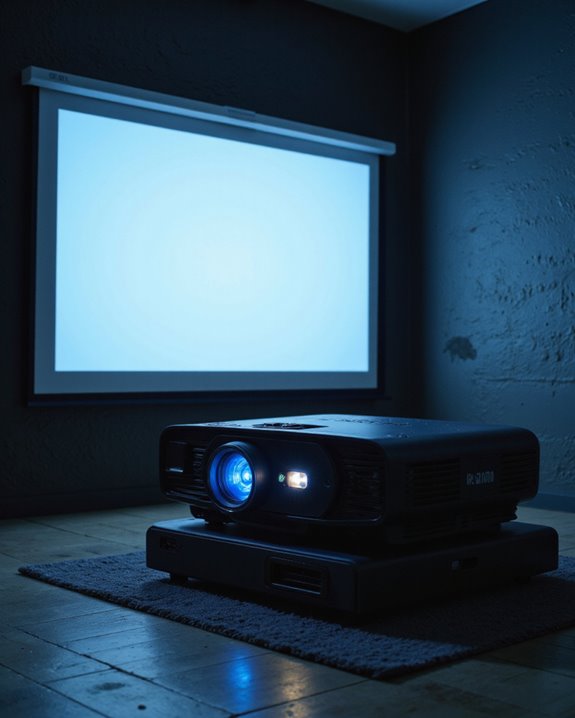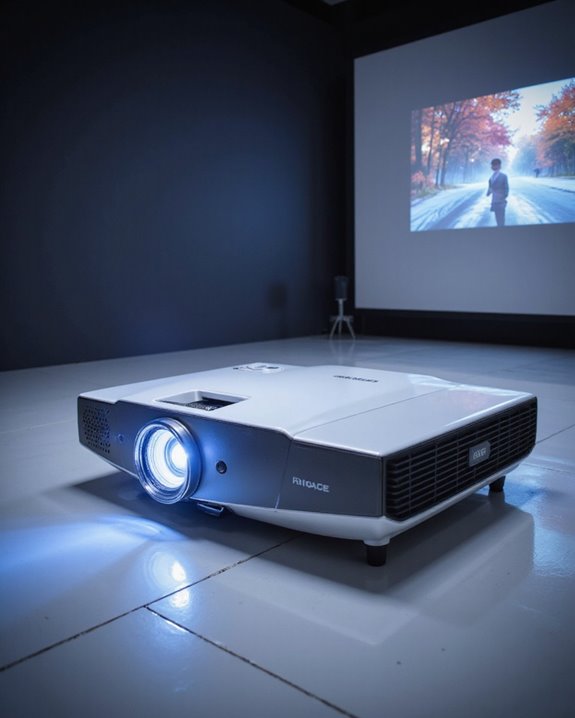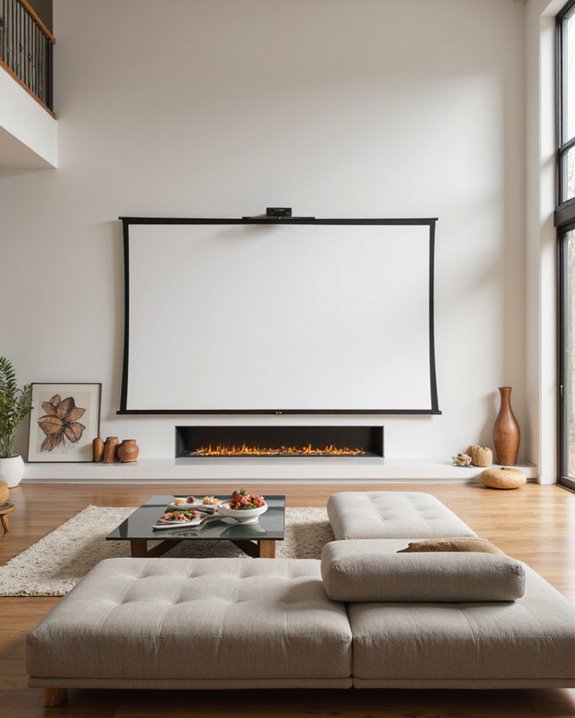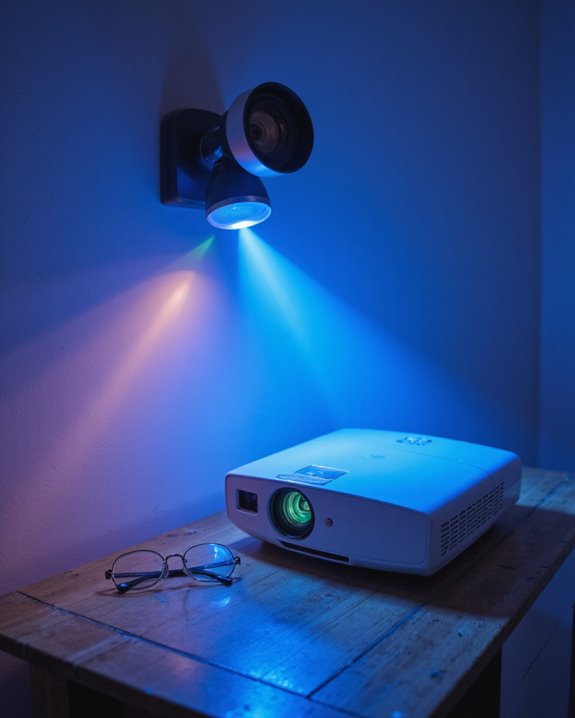4K projectors are often considered worth the investment for home theater setups, offering four times the resolution of 1080p for sharper images and reduced pixelation. They feature High Dynamic Range (HDR) for vibrant color and enhanced contrast, with brightness ranging from 1,800 to over 3,300 lumens suited to different lighting. While entry models start around $450, premium units cost more but support future-ready formats and large screens. Further details can clarify installation, user satisfaction, and long-term value.
Key Takeaways
- 4K projectors deliver significantly sharper, more detailed images than 1080p, greatly enhancing movie and gaming experiences.
- Modern 4K projectors support HDR and wide color gamuts, offering more lifelike visuals and better contrast in home theaters.
- The market shows high user satisfaction, especially when paired with proper setup and dedicated viewing spaces.
- Costs are higher upfront, but long-term value and future-proofing justify the investment for serious home theater enthusiasts.
- Compact designs, smart features, and flexible connectivity make 4K projectors easy to integrate into various home environments.
Advantages of 4K Projectors for Home Theaters
Because home entertainment technology continues to advance, 4K projectors have become a leading choice for creating immersive home theater experiences. The primary advantage is superior image resolution—4K means the projector displays four times the pixels of standard 1080p models, resulting in sharper detail and less visible pixelation, even on screens 100 inches or larger. This clarity benefits movie viewing, gaming, and streaming high-resolution content. Many 4K projectors use eco friendly materials in their construction, supporting sustainability. Customizable settings allow users to adjust brightness, color accuracy, and contrast to suit different rooms and lighting conditions. High Dynamic Range (HDR) support expands color and contrast, making images more vibrant and lifelike. Additionally, 4K projectors often incorporate advanced image processing technologies that further enhance picture quality and smoothness. Overall, 4K projectors offer a cost-effective, flexible, and future-proof home theater solution.
Key Features That Set 4K Projectors Apart
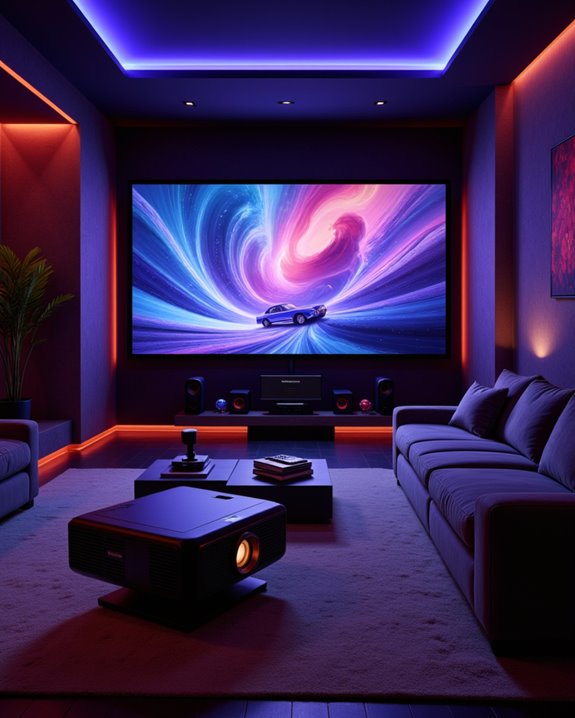
A 4K projector distinguishes itself through a combination of advanced display technology, versatile connectivity, and thoughtful design. The standout feature is its ultra-high resolution, either 3840 x 2160 or 4096 x 2160 pixels, delivering sharp detail and clarity. Color accuracy is enhanced by laser technology, which uses lasers instead of traditional bulbs for improved color performance and longer lifespan. Many models offer High Dynamic Range (HDR) support, boosting contrast and realism. Key features include:
- Multiple aspect ratios (16:9, 4:3) for flexible content viewing
- Smart platforms like webOS or Android TV for built-in streaming
- Wi-Fi, Bluetooth, HDMI, and USB connectivity
- Compact, lightweight form factors
- Portable options with rechargeable batteries
- Brightness and image quality capabilities that excel in well-lit environments
These features collectively set 4K projectors apart for home theater use.
Market Trends and Adoption Rates
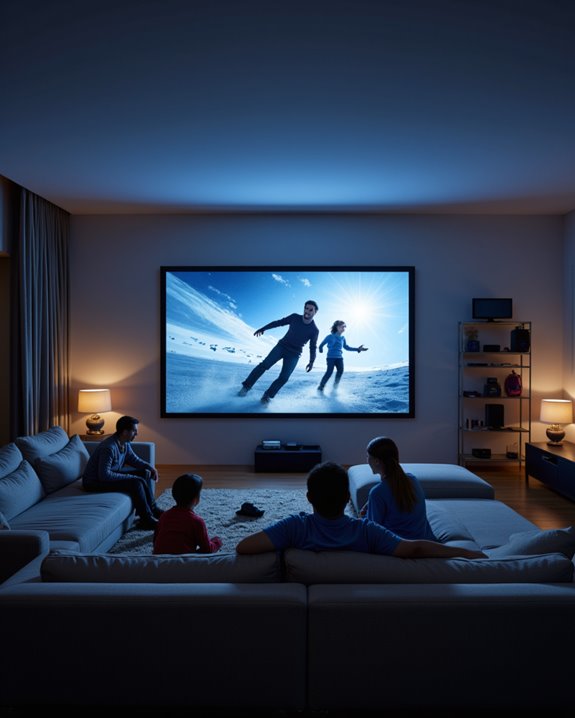
How is the 4K projector market evolving in today’s technology landscape? The 4K projector segment—devices displaying ultra-high-definition (UHD) images at four times the resolution of standard HD—shows rapid market adoption worldwide. This segment was valued at $3.5 billion in 2023, with projections reaching $9.8 billion by 2032. Growth is driven by expanding home entertainment, digital education, and corporate applications. Regional growth patterns highlight:
- North America: Dominates market adoption due to high consumer spending and advanced infrastructure.
- Asia Pacific: Fastest regional growth, fueled by urbanization and government initiatives.
- Europe: Mature market, experiencing steady but moderate expansion.
Key drivers include increased 4K content availability, improvements in projector technology, and wider use in smart homes and hybrid workplaces. Leading brands continue to innovate, further boosting adoption rates.
User Experience and Satisfaction
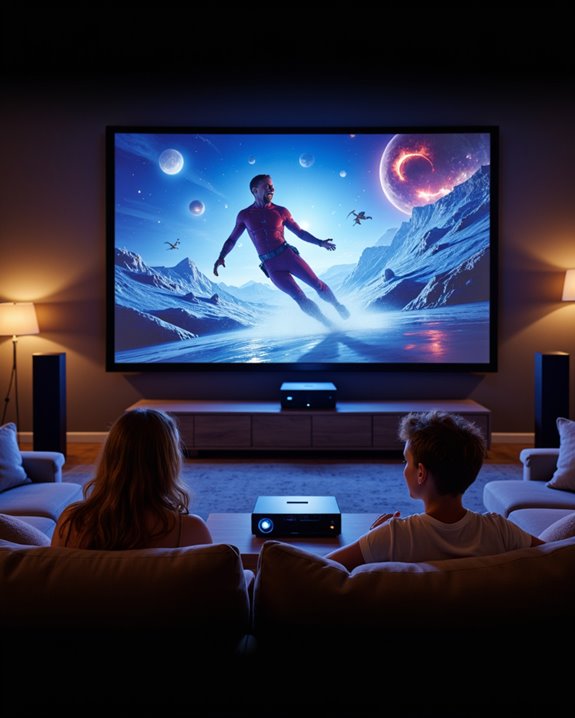
When evaluating user experience and satisfaction with 4K projectors for home theaters, visual quality stands out as a primary factor influencing positive feedback. 4K projectors, which display images at four times the resolution of standard 1080p high-definition (HD) models, consistently deliver sharper and more detailed visuals. Customer reviews highlight the cinematic experience, enhanced by improved color accuracy, contrast, and high brightness levels. Users appreciate the immersive, big-screen effect and easy access to 4K content from streaming services. However, setup challenges are frequently mentioned. Achieving ideal image quality may require careful projector placement and calibration. Some users encounter difficulties with installation, especially when selecting appropriate projection surfaces. Proper mounting hardware and surface texture considerations can significantly impact the overall viewing experience. Overall, satisfaction rates remain high—especially among those who invest in quality models and have a suitable, dedicated viewing environment.
Technical Specifications to Consider
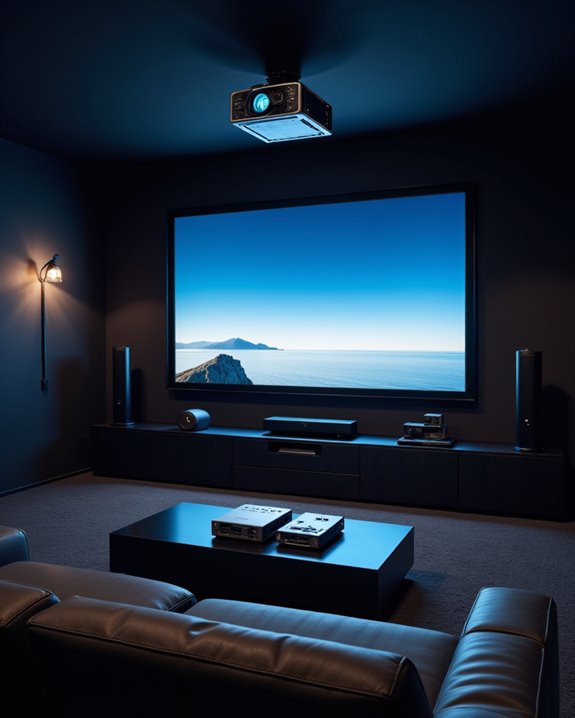
Visual performance in 4K projectors depends on several technical specifications that directly impact picture quality and usability in home theaters. Resolution standards are essential; true 4K UHD means 3840×2160 or 4096×2160 pixels, offering four times the detail of Full HD. Some models use pixel-shifting to achieve this high clarity. Brightness metrics, measured in lumens or ISO lumens, indicate how well a projector performs under different lighting. For example:
- 1,800 ISO lumens suit moderately lit rooms.
- 3,300–10,000 lumens handle brighter spaces.
Contrast ratio, such as 1,000,000:1, improves image depth. High Dynamic Range (HDR) support, wide color gamut coverage (like BT.2020), and refresh rates of 60–120 Hz further enhance realism. Installation flexibility depends on lens quality and throw ratio.
Financial Considerations and Budgeting

Projecting a realistic budget for a 4K home theater setup involves several key expenses. Cost comparison starts with the projector itself: entry-level 4K models cost $450–$700, while mid-range units like the Epson Home Cinema 5050UB average around $3,000. Premium projectors can reach $9,000 or more, with price increases driven by brightness, contrast, and laser technology. Budget planning should include:
- Lamp-based projectors, which need bulb replacements ($100–$300 each)
- Laser projectors, with longer lifespans but higher upfront costs
- Supporting equipment, such as 4K UHD sources, high-speed HDMI cables, screens, and sound systems
- Mounting hardware and installation services
- Maintenance, calibration, and warranty coverage
Choosing between lower-cost and premium options means weighing image quality, maintenance, and long-term value.
Future-Proofing Your Home Theater With 4K
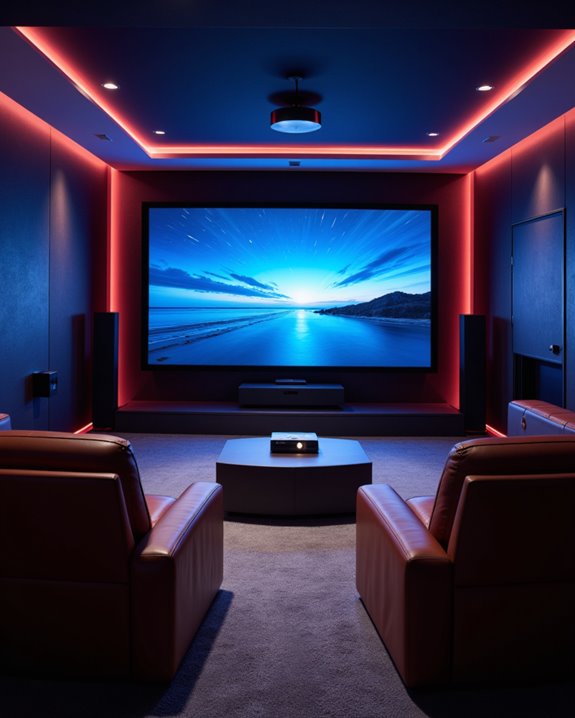
As 4K resolution becomes the industry standard for movies, television, and gaming, selecting a 4K projector is a practical way to future-proof a home theater system. 4K projectors display images at approximately 3,840 by 2,160 pixels, which is four times the resolution of traditional 1080p (Full HD) projectors. This higher resolution supports content preservation, allowing users to experience new movies and games at their intended quality. As more content is released in 4K, these projectors avoid the need for frequent upgrades. Leading brands, known for strong brand reputation, often include advanced features like laser technology for maintenance-free operation and HDMI v2.1 support for gaming. For those investing in large screens or bright rooms, 4K projectors deliver superior clarity and future-ready performance.
Frequently Asked Questions
How Difficult Is It to Install a 4K Projector at Home?
The installation challenges for a 4K projector include precise placement, secure mounting, cable management, and compatibility with room structure. Calibration procedures—such as display settings and color adjustments—are essential for ideal image quality, often requiring technical knowledge or professional assistance.
What Maintenance Do 4K Projectors Typically Require?
As time marches on, 4K projectors demand regular lens cleaning, periodic air filter care, and bulb replacement. Proper ventilation, cable inspections, software updates, and careful calibration form the backbone of reliable projector performance and longevity.
Can 4K Projectors Be Used Outdoors for Movie Nights?
Using 4K projectors in an outdoor setup is feasible, provided weather considerations are addressed. Adequate brightness, protection from moisture, and portability are key. Specialized outdoor models with splash resistance, carrying cases, and robust connectivity options enhance their suitability.
Do 4K Projectors Have Built-In Speakers or Require External Audio?
Like a jack-of-all-trades, many 4K projectors feature built in speakers for convenience and portability. However, users seeking superior sound often prefer connecting external audio systems, especially in larger rooms or dedicated home theater environments.
How Do 4K Projectors Perform With Streaming Services and Smart Devices?
4K projectors offer strong streaming compatibility, with built-in smart TV platforms, HDR support, and casting features. Smart device integration is seamless via Wi-Fi, Bluetooth, HDMI, and USB-C, enabling direct streaming and connectivity with various home entertainment ecosystems.

